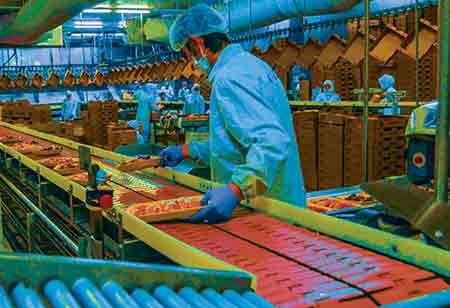Thank you for Subscribing to Food Business Review Weekly Brief
- Home
- Topics
- Alternative Proteins and Plant Based Food
- Beer and Wine
- Canned Beverages
- Coffee And Tea
- Food and Beverage Consulting
- Food and Beverage Financial Service
- Food And Beverages Marketing
- Food Distributors
- Food Ingredients
- Food Sustainability
- Plant Based Food and Beverages
- Seafood Suppliers
- Supplement Manufacturing
- Wine Investment
- News
- Vendor Viewpoint
- CXO Insights
- Conferences
- Newsletter
- CXO Awards
-
How Cutting Edge Technologies are Transforming Bakery Processing Lines
The bakery industry is a significant exporter, accounting for forty percent of production. The highest costs are those of raw materials,

By
Food Business Review | Friday, February 25, 2022
Stay ahead of the industry with exclusive feature stories on the top companies, expert insights and the latest news delivered straight to your inbox. Subscribe today.

Line automation, optimal control of parameters including temperature and relative humidity, and novel ingredients make the bakery business one of the most technologically advanced in the food industry.
FREMONT, CA: The bakery industry is a significant exporter, accounting for forty percent of production. The highest costs are those of raw materials, due mainly to the global availability of common wheat, and packaging, due primarily to packaging methods. Domestic consumption consists mostly of bread alternatives, cookies, and industrial confectionery.
The bakery industry is characterized by a high level of partial or total mechanization and automation of individual machines and entire production lines. The many industrial realities compete based on price, innovations, promotions, forms, and packaging. In addition to huge corporations, there are a lot of small and medium-sized businesses, with a supply concentration in northern Italy.
Industry 4.0 implementation in the production of bread items
Automation of production processes enables accurate and reliable control and enhanced product traceability. The design of the industrial part, the information system, the machines, and the plants are becoming an important milestone for all bakery companies, particularly those that produce products for people with food intolerances, gluten-free and lactose-free products, as well as organic food manufacturers.
Automation and computerization of the production lines make gluten and non-organic ingredient contamination avoidance more dependable. With remote control of devices such as planetary mixers, dosing machines, and rotary ovens, it is feasible to collect data on production traceability and operate and shut down the machine according to a production cycle-appropriate program.
For instance, the oven can be preheated before the start of production. Additionally, it is possible to monitor the output and performance of each machine. Automated and mechanized operations include production control, regulation, and management. Due to the necessity for production specialization and fast production lines, the bakery industry's automation and mechanization are also growing.
Between the metal container and the bread, goods are release agents
The responsibility of release agents is to facilitate the demolding of the product. This procedure is crucial because it enables the production of a homogeneous product, the reduction of processing time, and reduction of processing expenses.
They can include oil that operates as a carrier without releasing action, waxes with release and thickening properties, emulsifiers that increase the product's shelf life and prevent oxidation, and water that acts as a thickening agent together with waxes and antioxidant-functioning components.
The most commonly used vegetable oils are rapeseed and sunflower, which contain multiple unsaturated fatty acid chains and are heat-resistant. Palm oil is primarily used to increase oxidation stability and reduce carbonization.
Vegetable waxes are combinations of esters, alcohols, and saturated acids with 14 to 30 carbon atoms in their chain. These are natural chemicals derived from plants, such as Carnauba wax, derived from the leaves of a palm tree, liquid waxes, and wax combinations used for their releasing ability.
Utilizing plant emulsifiers to create an emulsion between two otherwise incompatible liquids. The selection of a releasing agent is contingent on numerous factors. The most prevalent is lecithin derived from rapeseed oil (E322).
Otherwise, the baked product could have undesirable odors and flavors. In this instance, evaluating the oil smoke point or the temperature at which the oil begins to emit white smoke is essential.
Consideration must also be given to the release agent's adhesion properties, i.e., that the agent sticks to the mold walls and does not slide along the bottom. There would be a frying effect at the bottom of the baked good, and removing the baked good from the mold would be difficult.






